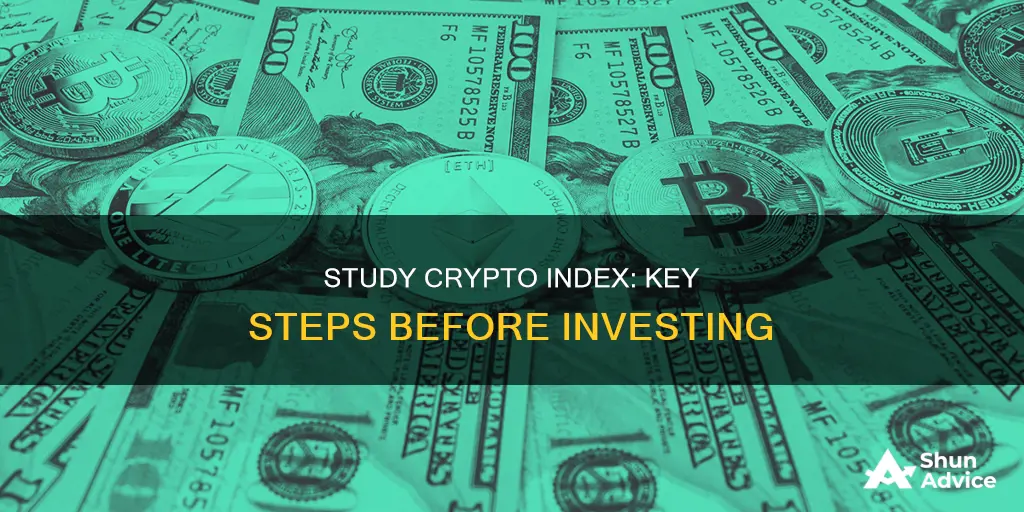
Investing in cryptocurrencies is a daunting task, especially for first-timers. The crypto market is volatile, and there are many scams to watch out for. However, cryptocurrencies may be an asset class worth investigating as they can add diversity to your portfolio, and their price volatility can offer good returns. Here are some ways to study the crypto coin index before investing:
- Check out the project's website. Look for a website that is up-to-date, easy to use, free of errors, discloses team members and partnerships, defines the token's objective, and offers a white paper.
- Read the white paper. This is one of the most important tools for evaluating a cryptocurrency as it outlines the goals and strategies for its usage. It also includes tokenomics, such as distribution among investors and supply limits.
- Scrutinize social media channels. Visit the crypto community's Twitter, Reddit, or Discord channels to assess engagement and moderation.
- Analyze the project team and partnerships. Research team members to determine their reputation and thought leadership in the blockchain ecosystem. Look for partnerships with well-known brands and verify that they are legitimate.
- Evaluate market metrics such as market capitalization, trading volume, supply and demand, and price history.
- Study price history and avoid coins with exaggerated highs followed by sudden drops, as this may indicate a pump-and-dump scam.
- Determine the cryptocurrency's utility. Look for coins that offer practical value, such as solving an issue within the blockchain network or enhancing its functionality.
- Understand technical analysis by using tools such as trading charts and technical indicators to analyze market trends and make informed trading decisions.
- Consider the level of risk and potential returns. Cryptocurrencies are generally more volatile and risky than stocks or bonds, so it's important to diversify and reduce risk.
- Research blockchain technology, including consensus mechanisms such as proof-of-work and proof-of-stake protocols, to understand how they may impact your investment.
- Familiarize yourself with hot and cold wallets. Hot wallets are connected to the internet and convenient for frequent trading, but they are more vulnerable to hacking. Cold wallets, such as hardware or paper wallets, are more secure but less convenient for frequent use.
| Characteristics | Values |
|---|---|
| Number of cryptocurrencies | 19,000 |
| First cryptocurrency | Bitcoin |
| Largest cryptocurrency by market cap | Bitcoin |
| Other large cryptocurrencies | Ethereum, BNB, and Solana |
| Crypto exchange platforms | Binance, Coinbase, Crypto.com, Gemini, Kraken |
| Crypto data aggregators | CoinGecko, CoinMarketCap |
| Crypto tools | KryptView, BSCCheck, TokenSniffer |
| Crypto social media platforms | Discord, Telegram, Twitter |
| Crypto white paper | An authoritative document outlining the goals and strategies for the cryptocurrency's usage |
| Crypto market metrics | Market capitalization, trading volume, max supply, circulating supply |
| Crypto price history | Gradual increase in price over time |
| Crypto utility | Coins that offer utility in the blockchain ecosystem |
| Crypto wallet | Hot wallet, cold wallet |
What You'll Learn

Understanding the difference between hot and cold wallets
Hot wallets are always connected to the internet, making them easily accessible from internet-enabled devices such as phones, tablets, and laptops. They are widely adopted by cryptocurrency users as they make it easier to transfer and receive cryptocurrency. Hot wallets are used for temporary key storage and to send and receive cryptocurrency. They are also used to view how many tokens are available. However, because they are always online, they are more vulnerable to hacking and phishing attacks. It is important to only keep small amounts in your hot wallet and to ensure it is backed up, kept up to date, encrypted, and secured with a strong password.
Cold wallets, on the other hand, are offline and come in the form of a physical device, such as a USB stick. They are not connected to the internet or another device, making them less susceptible to hacking. Cold wallets are considered one of the safest methods for securing digital currency. They are better suited for long-term storage and for those seeking additional security for their digital assets. Cold wallets usually cost between $50 and $200. Examples of cold wallets include hardware wallets and paper wallets.
It is a good practice to use both types of wallets, storing keys that are not needed immediately in a cold wallet, and keeping a small portion of your crypto-assets in a hot wallet for immediate or near-future use.
Strategies for Crypto Investment Without Coin Purchase
You may want to see also

Reading the white paper
Understanding the Basics
Before diving into the white paper, it is important to have a basic understanding of cryptocurrency and blockchain technology. Familiarize yourself with key concepts such as consensus mechanisms (proof of work and proof of stake), nodes, soft and hard forks, and the Byzantine general problem. This foundational knowledge will help you better comprehend the content of the white paper.
Identifying the Problem and Solution
A good white paper will clearly articulate the problem that the cryptocurrency project aims to solve. It will explain the current challenges or limitations of the existing system and present the cryptocurrency as a solution. The introduction section of the white paper should provide insight into the motivation behind the project and how it differs from other solutions in the market.
Assessing Real-World Utility
Beyond just being a currency, many crypto coins have additional utility or functions. Some are used for the governance of a project, while others are non-fungible tokens that provide ownership rights. Evaluate the real-world utility of the cryptocurrency and how it differs from other coins in the market.
Analyzing Consensus Mechanisms
Understanding how the cryptocurrency achieves consensus in the network is critical. Different consensus mechanisms, such as proof of work or proof of stake, determine how nodes in the network reach an agreement on the validity of transactions without directly communicating. This is a fundamental aspect of decentralized technology.
Examining Token Distribution
Look into how the initial coins were distributed. In proof-of-stake projects, for example, a significant portion of the initial coins may be offered to venture capitalists and project developers, which could be a sign of a pump-and-dump scheme. Understanding the token distribution can help you assess the potential for restricted project growth.
Technical Explanation and Roadmap
While technical explanations can be complex, focus on understanding the big picture of the project. Look for graphs, summaries, and real-world examples that help clarify the technology and its applications. Additionally, look for a roadmap in the white paper, which outlines the project's goals and the timeline for achieving them.
Evaluating the Team and Updates
Although not all white papers include this information, it is important to consider the credibility and expertise of the team behind the project. Are the authors easily verifiable? Have they provided their backgrounds and qualifications? Regular updates to the white paper also indicate a responsible and committed development team.
Fact-Checking and Red Flags
Don't take the white paper at face value. Fact-check the information presented and be cautious of unverifiable claims. Look for citations and references to support the data and ideas presented. Be wary of overly grandiose promises, lack of detail, or hidden white papers, as these could be red flags indicating a poor-quality or scam white paper.
In conclusion, reading a white paper is a critical step in studying the crypto coin index before investing. It provides essential information about the project's technology, goals, and potential. By considering the points above, you can make a more informed decision about whether to invest in a particular cryptocurrency project.
The Beginner's Guide to Cryptocurrency and Altcoin Investing
You may want to see also

Researching the project team and partnerships
When considering investing in a cryptocurrency project, it is important to research the team behind it. The calibre and competence of the team can be a powerful predictor of the project's ultimate success. Here are some key considerations when researching the project team and partnerships:
Team Expertise and Qualifications
Look into the professional experience and qualifications of the team members. Do they have relevant experience in the blockchain industry or related fields? Review their profiles on LinkedIn or other similar platforms to understand their work history, educational background, and previous projects. Assess if they have a deep understanding of blockchain technology and its real-world applications. Also, consider if they have transferable skills and experiences, as past successes in tech projects, even outside the blockchain space, can indicate adaptability and competence.
Track Record and Credibility
Evaluate the team's previous achievements. Have they successfully launched other crypto projects or built and scaled startups? Do they have experience relevant to the problems the cryptocurrency project aims to solve? A proven track record can reduce investment risk. Additionally, look out for any red flags, such as involvement in dubious projects, bad press, or a history of failed ventures.
Commitment Level
Assess the team's commitment to the project. Are they working on it full-time or have a significant stake in the cryptocurrency? Teams with a higher level of commitment are more likely to be invested in its long-term success. Check if team members have locked their tokens for a specific period, indicating their belief in the project's prospects.
Transparency and Communication
Evaluate the team's level of transparency and communication with the community. Do they regularly update investors and stakeholders through blog posts, newsletters, social media channels, etc.? How do they handle crises or setbacks? A transparent and effective communication strategy can instil confidence in investors.
Advisory Board
Examine the advisory board and assess their credibility and level of involvement. An experienced and knowledgeable advisory board can add significant value by providing strategic guidance, industry connections, and validation.
External Evaluations
Look for external evaluations of the project and its team, such as independent audits of the project's code and security infrastructure. External opinions, reviews, or ratings from crypto-focused forums, blogs, or podcasts can also provide valuable insights. However, remember to cross-check information and consider potential biases.
Strategic Partnerships
Research the project's strategic partners. Established partners can provide additional resources, publicity, and industry knowledge. While the number of partners is important, focus on the quality of partnerships. Cooperations with renowned companies, official institutions, or research institutes can significantly enhance the project's credibility. Verify the nature of the partnerships by checking press releases or other external sources.
Altcoin Investing Guide for Indians: Getting Started
You may want to see also

Evaluating the cryptocurrency's market metrics
Market metrics are essential to understanding a cryptocurrency's performance and potential. Here are some key market metrics to consider when studying crypto coins before investing:
- Market Capitalization: Market capitalization, or market cap, is calculated by multiplying the price of a cryptocurrency by the total number of coins in circulation. While it's generally safer to invest in cryptocurrencies with a high market cap (over $1 billion), this doesn't guarantee low risk. It's important to consider other factors as well.
- Trading Volume: This metric indicates the number of times a coin is traded during a specific period. A high trading volume means that a coin is being actively bought and sold, leading to increased liquidity and price stability.
- Circulating Supply: Circulating supply refers to the number of coins actively traded or held in wallets. This metric helps understand the potential scarcity of a coin, which can impact its price.
- Price History: Analyzing the price history of a cryptocurrency is crucial due to the market's volatility. Look for gradual price increases over time and avoid coins with exaggerated highs followed by sudden drops, as these could indicate a pump-and-dump scheme.
- Hash Rate: The hashrate is the speed at which a cryptocurrency is mined. A higher hashrate indicates a larger number of miners verifying transactions, making the cryptocurrency more secure.
- Maximum Supply: Most cryptocurrencies have a maximum supply, or a limit to the number of coins that will ever exist. This can impact the scarcity and, consequently, the price of the coin.
When evaluating these market metrics, it's important to use reliable sources such as CoinMarketCap, CoinGecko, and TradingView. These platforms provide valuable insights into market capitalization, trading volume, price history, and other relevant data. Additionally, it's essential to consider multiple factors when making investment decisions, as relying solely on market metrics may not provide a comprehensive understanding of a cryptocurrency's potential.
Gulf Coin: A Smart Investment Move?
You may want to see also

Scrutinising social media channels
Social media is a powerful tool for researching and investing in cryptocurrencies. It offers a direct line of contact with consumers and other investors, and can be a valuable indicator of a coin's performance and potential. However, it is important to exercise caution when using social media as a source of investment advice, as it may also be a breeding ground for misinformation, fraud, and market manipulation.
Understanding the Role of Social Media in Crypto
Social media has played a pivotal role in the rise of cryptocurrencies, particularly in terms of increasing awareness and driving up prices. The decentralised nature of crypto aligns with the open and accessible nature of social media platforms. Crypto communities thrive on social media, with users sharing their experiences, insights, and reviews. These communities are often passionate and highly engaged, making social media a key source of real-time insights for investors.
Benefits of Social Media for Crypto Investors
Social media allows investors to gauge sentiment, viability, and potential currency manipulation. It can be a useful tool for understanding the broader conversations and sentiments surrounding a particular cryptocurrency, which can inform investment decisions. Additionally, social media can provide early access to news and developments, allowing investors to act quickly and potentially gain an edge over the broader market.
Navigating the Risks of Social Media
While social media offers valuable insights, it is important to approach it with a critical eye. The anonymous and unregulated nature of many social media platforms makes them susceptible to fraud and market manipulation. Fraudsters may disseminate false information, impersonate legitimate sources, or create fake profiles to promote certain coins. It is crucial to verify the identity of any source of investment information and be wary of investment recommendations that seem too good to be true.
Best Practices for Using Social Media for Crypto Research
When using social media as a research tool for crypto investing, it is important to follow reputable sources and cross-reference information from multiple channels. Look for trusted influencers and industry experts who provide transparent and objective insights. Additionally, utilise social media sentiment analysis tools, such as Ipsos Synthesio and Sprout Social, to identify broader trends and potential red flags.
In conclusion, social media can be a double-edged sword when it comes to crypto investing. While it offers valuable insights and real-time information, it is important to approach it with caution and a critical mindset. By understanding the benefits and risks associated with social media, investors can make more informed decisions and navigate the crypto landscape more effectively.
A Beginner's Guide to Investing via Coinbase
You may want to see also
Frequently asked questions
It's important to spend time investigating whether a cryptocurrency is legitimate before investing. You can start by considering how you heard about it and whether it was from a reliable and trusted source. You should also be wary if the focus is on how much money it will make investors, rather than the project the currency enables.
Other red flags include a lack of white paper, or a poorly written one, and a lack of publicly listed board members or partner organisations.
You should consider the cryptocurrency's market metrics, such as market capitalisation, trading volume, supply and demand, and price history. It's also worth looking at the project team and partnerships, and whether the cryptocurrency has a utility.
It's also important to remember that cryptocurrencies are highly volatile and unpredictable, so it's a good idea to do your research before investing.
You can invest in a cryptocurrency directly, or via a stock or bond index fund. There are also cryptocurrency index funds, which invest in a group of cryptocurrencies, although these are mostly theoretical at the moment.







